History
In 1870, as the Prussians were invading France, a hundred or so ladies met with Archbishop Monseigneur Ginoulhiac to implore the protection of the Virgin Mary for the city of Lyon. The prayer was answered, the Prussians were stopped at Nuits-Saint-Georges, and thus Lyon was spared.
As an act of thanksgiving, the city built the basilica of Notre Dame de Fourvière.
Inspired by this fervent desire, Mr Gindre decided to build a chapel, since the Prussians did not get past the River Loire.
The Gindre family
On 23 October 1869, Mr Claude Gindre (1842-1898), an important silk industrialist from Lyon, bought the property of Laverdines. He continued the improvements begun by his predecessor, Mr Gabriel Lalouel de Soudeval (1800-1862).
Thanks to Claude Gindre’s rigorous management of the domain, many jobs and thus livelihoods for many families were created. He built houses and a chapel.
On his death, he was succeeded by his son, Henri, who reinstalled a new distillery in the chapel farm.
Construction
In 1873 the architect Adolphe Bouveault de Nevers (1834-1892) together with the master builder Alexandre Bardin of Clamecy carried out this gothic style project using stone from the quarries in the Nièvre region. The chapel was built outside the château grounds so that every inhabitant could go there for prayer and silent reflexion. The chapel should have been the parish church from the outset, but in actual fact, did not enter the public domain until 1983, when it was bought for a symbolic franc.
Exterior
Statue of the Virgin Mary
The statue of the Virgin Mary is made of cast iron. It was cast in the Villard and Tournier foundries in Lyon (33, quai St Antoine). Its original place was on the roof of the chapel, but it fell in 1984.
The Virgin Mary of Laverdines is a replica of Our Lady of Fourvière in Lyon. The folds of the dress, the cape and the starred crown are identical. The only difference is that the hands and face of the statue in Lyon are comparatively larger, in order to be seen from the bottom of the hill of Fourvière. In Lyon the statue is 5.6 metres high and weighs 3 tons.
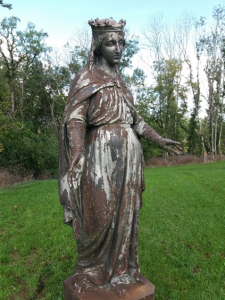
The 4 Evangelists




The Evangelists are the authors of the Gospels.
They are represented around the upper half of the bell tower, at the four corners.
Matthew (front left), symbolized by a winged man or angel, is the wise man. Saint Matthew begins his gospel with the genealogy of Jesus.
Mark (rear right), symbolized by a lion, is the king.
Mark begins his gospel with the preaching of John the Baptist in the desert.
Luke (rear left), symbolized by an ox, is the priest. Luke speaks of the the priest Zechariah in the temple, where animal sacrifices took place.
John (front right), symbolized by an eagle, indicating spiritual heights, is the prophet. The stela is empty, and the actual statue is on the floor to the left as you enter the chapel.
.
Entrance
We enter the chapel by a narthex, that is a porch for penitents or the unbaptized. We are greeted by little grimacing statues, the sculptor of which is not known.
Interior
To the right, a spiral staircase leads up to a gallery from which one can follow services, and to a double terrace offering a view of the surrounding countryside and the château.
On this landing is the church bell, bearing the inscription
SIT NOMEN DOMINI BENEDICTUM Blessed be the name of the Lord CLAUDE GINDRE PATRON DE GINDRE-PAYEN PATRON (his wife)
Just in front of the choir
There are two very beautiful sculptures in ĺimestone by Jean Gautherin, dating back to 1877, as can be seen on the pedestal.
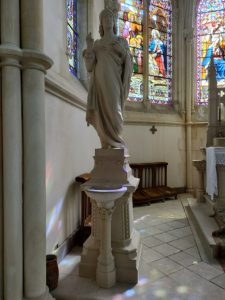
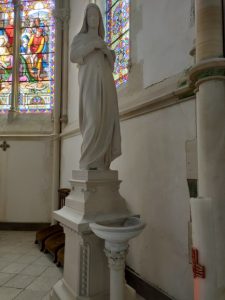
The statues represent:
☆ The Virgin Mary at the Annunciation. Her expression is one of meditation, and her hands are crossed on her breast in submission to the words of the angel Gabriel.
☆ The Sacred Heart of Jesus is a devotion the the heart of Jesus Christ, as a symbol of divine love, by which God took on human form and gave His life for mankind.
Jean Gautherin 1840-1890
Gautherin was born in the Morvan region into an illiterate farming family. He studied classics in Paris, later working in the faubourg Saint-Antoine.
On 31st October 1864 he was admitted into the Paris School of Fine Arts, specifically in the workshops of Charles Gumery and Auguste Dumont. His work was on show for the first time at the 1865 Exhibition.
His work can be seen in Nevers city hall, in the cemeteries of Montparnasse and Père Lachaise, in the town hall of the 5th district in Paris, in the Orsay Museum, in Rungis town hall, in the casino in Monte Carlo, Monaco, and many other places.
He was awarded the ‘Chevalier de la Légion d’Honneur ‘(Knight of the Legion of Honour) in 1878. The three stained-glass windows of the East opening

On the left: the Nativity
☆ On the right: Jesus is taken down from the cross, where Mary saw her Son die.
☆ In the centre: the Virgin Mary is crowned by an angel and blessed by God.
☆ The altar decoration includes a cross with 3 bronze candlesticks on either side.
☆Also on the altar is a small stone statue of a person from the Romanesque period. Its origin is unknown.
☆The neo-gothic style chairs and prayer kneelers are covered in velvet. The wooden pews date back to 1875.
Basement
Stairs behind the altar lead to the sacristy and the stoking room for the heating.
☆The sacristy is a room in a church containing furniture where articles of worship, vestments, and registers are kept, and where the priest prepares for a service. The person in charge of the sacristy is the sacristan. He may be a clergyman or a layman.
The vestment cabinet is the main piece of furniture in the sacristy. Vestments are often embroidered with gold.
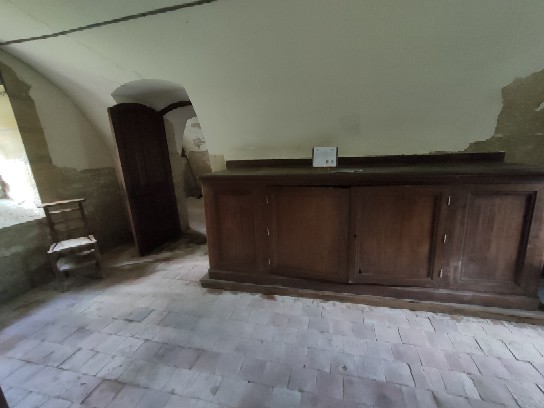
However, the sacristy is no longer in use and has been empty for several decades.
☆The heating system was fueled by coal. The fireplace has been dismantled, but one can still see where the coal was stored in the adjoining room. Hot air circulated through vents in the floor, but there was no fan to pulse the air. The vents can be seen in the aisle.
Restoration work :
The chapel has undergone restoration work several times:
At the beginning of the 20th century, restoration of the capitals of certain pilasters which had fallen.
1949-50: restoration of the 13 stained glass windows. The glass was cleaned, the lead cames were restored, as was the putty used to secure the glass into the cames, thus making the joints watertight again.
1967: restoration of stained glass windows, this time those of the south transept, of the rose window and of two bays.
December 1983: the village purchased the church along with the path leading to it.
November 1984: the statue of the Virgin Mary having fallen from the roof, it was necessary to move the statue, partially repair the roof and build a pilaster.
1984-85: following storm damage, the stained glass windows in the choir and one at the south end were repaired.
1989: restoration of the stained window on the south side of the nave (inspection, cleaning, lead cames…)
1991: partial repair of the lead gutters
1991-92: replacement of the bell tower cornices and balusters.
New gutter on the outside of the bell tower.
1996: repair of stained glass windows damaged by children, and of one panel in the choir and one on the south side.
Protective wire netting was installed. Some of the zinc downspouts were replaced.
2019: extensive repairs to all the zincwork (gutters, terrace…)
More about Laverdines
☆ The chapel first belonged to the parish of Villequiers, later becoming part of the parish of Nérondes. We are currently waiting for it to be transferred to the parish of Baugy.
☆ In the 12th century, a large sanctuary dedicated to Saint Sylvain was built in Laverdines. This vast church fell into ruin, and was looted in 1803. It was demolished in 1805. Very little of it remains.
☆ At the beginning of the 20th century there was a remount annex created by the army. Horses were hosted there for twelve months before being taken to a depot to be broken and trained. The remount annex and its stables remained in use until the end of the First World War, becoming active once more at the outbreak of the Second World War.
☆ Around 1860 Lalouel de Sourdeval was the first to grow sugar beet on his land in Laverdines. After the sugary refinery, the distillery was built nearby. This booming business attracted many, and in 1877 there were more than 230 inhabitants in Laverdines. The distillery remained productive until the 1950s, when it finally closed down.
☆ The Château of Laverdines was erected by Lalouel de Sourdeval during the second half of the 19th century. Built of stone and brick (the bricks being made on site), it stands in beautiful grounds which boast a lake and a fountain which is close to the château opposite the front steps. Of Louis XIII style, the château was entirely renovated in the 1990s.
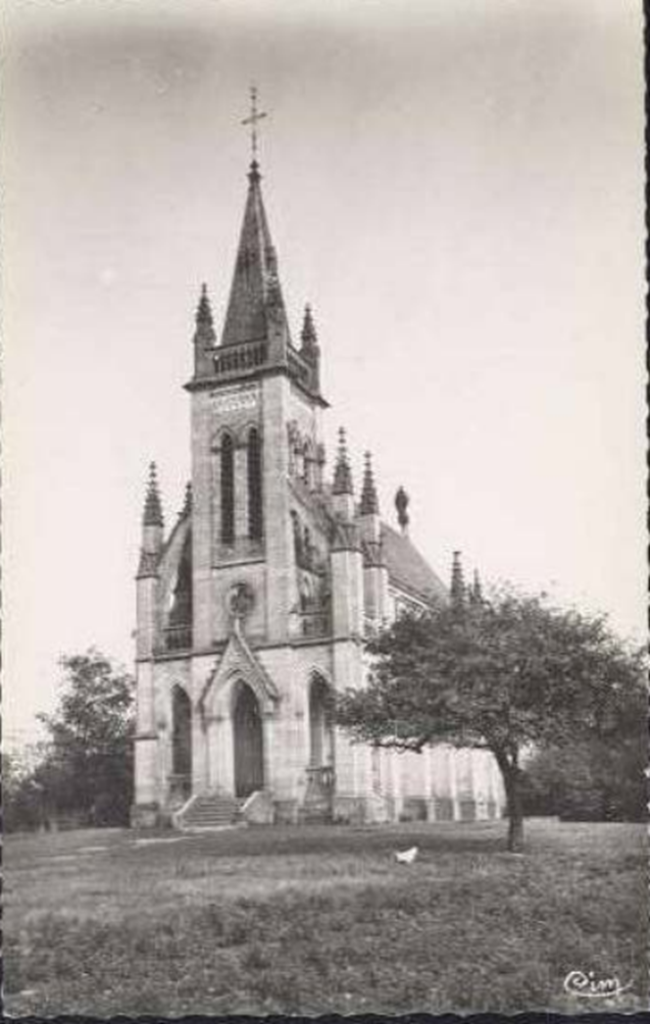
Photo taken before the fall of the statue of the Virgin Mary